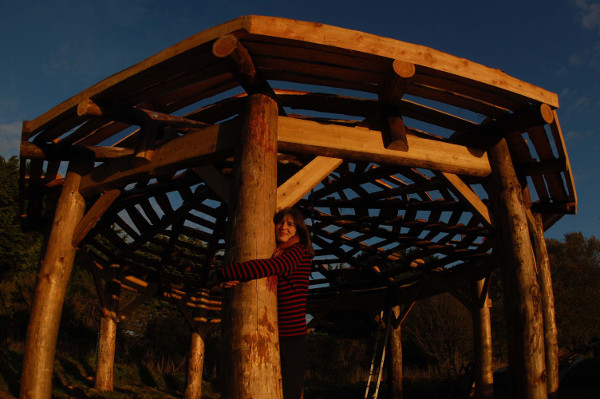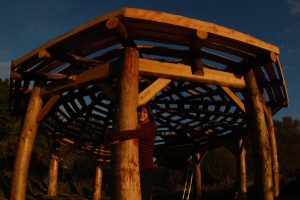“I’m not looking at this roundhouse as an investment – it’s my home, and at some point, usable stuff like the windows or stove can be taken away and used elsewhere, and the rest of the place will return to the earth.” – Tony Wrench
Contents
What are roundhouses?
Roundhouses are cylindrical – a common building shape that has popped up independently in many cultures and in many parts of the world throughout history. A circle would have been the most popular building footprint on the planet at one time – think mud huts, yurts, tipis(ish), igloos, wigwams (OK, they’re both domes), as well as hogans, crannogs, trulli, pallozas, rondavels, clochans and brochs.

They’re not so widespread in the modern world, as buildings need to be square to fit closely together in today’s high-density urban areas. The reason that roundhouses became so popular is probably because a curved wall is relatively stable and self-supporting, whereas a linear wall is not, and can be wobbly until it’s fixed to something.
Roundhouses can be made from most materials, in the same way that any other shaped house can. The most popular construction method currently in the UK is a timber frame (round or square timber) with walling infill. Loadbearing walls without a timber frame can also be used, using straw-bales (which have to be bent to shape, which can be tricky), cob, stone or rammed earth. There are more options with infill – all the above materials can be used, as well as wattle & daub, cordwood or hempcrete. The advantage with timber frame is that you can put the roof on and have a dry space to construct the walls / add fittings etc.

An interesting roofing option is the reciprocal frame roof. The most popular type has rafters radiating out like the spokes of a wheel – every rafter resting on the previous one, with no central support. The second most common reciprocal roof is the ‘whirling log’ variety, where there are no rafters, but instead, a set of ring beams radiate inwards from the walls, each one sitting on the previous one and twisted half a turn – i.e. the shape you would get if you sat one 50p on top of another so that the points of one overlay the flat edges of the one below – the coins getting smaller as they get higher. Alternatively, roundhouses can have a conventional roof where the tips of the rafters meet in the middle.

Because reciprocal roofs usually have quite a flat pitch, they’re often turfed. A turf roof looks right on a roundhouse, somehow. However, there are plenty of examples of higher-pitched shingle or thatched roofs. A reciprocal frame roof places very little spreading load on the ring beam and upright posts (so it doesn’t tend to push the walls out), meaning that the roof needs no further bracing or tie beams.
What are the benefits of roundhouses?
- The reason they appeared so often in history is possibly practical – a cylindrical shape is one of the easiest ways to make things stand up – try it with twigs.
- A cylindrical building has a lower surface area to volume ratio than any other shape (except a dome), reducing heat loss and making it easier and cheaper to heat.
- They also have a lower wind profile / sail effect than square or rectangular buildings, so are more stable and secure in high winds.
- They provide the maximum interior space for any given amount of materials (again, apart from domes).
- Many cultures have valued this shape for a variety of cultural and spiritual reasons; and people tend to enjoy them now because most of our buildings are square / right-angled and it provides a welcome change – literally, an out-of-the-box experience.
- Our friend Adrian has built a lot of round structures for schools, and the reason they like them is that they create a non-hierarchical space, with everyone sitting in a circle.

(Wholewoods roundhouse in London).
What can I do?
Attend a course and read books (especially Tony Wrench’s Building a Low-impact Roundhouse) to learn how to do it yourself, or hire a specialist to build one for you. If you’re going to build yourself, you can choose from various walling materials (see above), and they can potentially be more than one storey. Here are some tips for foundations and reciprocal frame roofs.
Foundations
There are two different types of foundation for basic roundhouses – buried post or free-standing.

If you want to build a garden shed or playhouse for example, the buried post variety (i.e. Iron Age style) is the simplest, quickest and cheapest option. The frame is kept upright and rigid by burying the bases of the vertical posts into the ground – as deep as you can get with your arm. This requires very little in the way of carpentry skills – no complex mortice & tenon or other joints. Timbers can be tied, bolted, pegged or pinned together. The downside to this technique is that eventually the posts will rot off at ground level, making the structure unstable. There are a few ways to retard the rotting, however:
- Pack the holes that the posts stand in with hardcore; depending on where your water table is, this could help drainage.
- Char the ends of the posts to make them more durable.
- You can buy bitumen sleeves that go over the bottom of the posts when they’re buried.
- Strip the perishable bark and sapwood from the posts before burying.
For serious, long-term or public buildings, roundhouses should be free-standing. Posts sit above ground level, away from moisture and soil. This means that the posts need to be properly jointed with mortice and tenons, with full, all-round wind bracing to ensure that the building is secure and stable.


Reciprocal frame roofs
Reciprocal frame roofs are fun to build. If you’ve never done it before, try it first with twigs, then progress to a full-sized version at ground level before attempting the real thing. You’ll need a ‘Charlie stick’ (a prop) to support the first rafter. Each successive rafter is balanced on the previous one. If your calculations are correct, there will be sufficient space to slot in the last rafter, after which you can pull away the Charlie stick and the roof will drop to its natural point of equilibrium. Make sure there’s no-one inside the building when you pull the stick out – just in case. Reciprocal roofs are easier to construct with roundwood. It’s easier to get them to locate – they will find their own resting place.

There are various systems to predetermine the geometry of a reciprocal frame roof, that are too complex to go into in much detail in an introduction, but the quantities that are interdependent are a) the pitch of the roof, b) the number and thickness of the rafters, and c) the size of the ‘eye’ hole left in the middle. You can’t determine these values separately – any two will determine the third. Here‘s some more detailed information. Leonardo da Vinci created a few interesting reciprocal structures, including a bridge. There are also square and rectangular reciprocal roof designs, but the commonest shape is round. You can use some (long) matchsticks arranged reciprocally as a pub trick to hold a pint of beer above the table. This demonstrates the primarily downward rather than spreading load of the structure (and it stops you getting too drunk).

Reciprocal roofs tend to have an amount of natural flex or spring due to their self-supporting nature. This is a facet of the structure and not necessarily a reason for concern. However, it’s important to select strong timber species for the rafters, like larch, douglas fir, ash or chestnut, and not brittle or radially-branching species like sitka spruce.
If the pitch is too shallow, it can go flat or invert/collapse. It’s also possible to miscalculate and end up with a pitch too steep for turf, so you might have to dismantle it and start again, or use a different roofing material. (NB: a turf roof needs to be battened between the rafters).
Further resources
- ‘That Roundhouse’ – the story of Tony Wrench’s roundhouse and his battle with the planners in Pembrokeshire.
- Reciprocal Frame Structures Made Easy – I wouldn’t go that far, but an interesting paper on reciprocal roofs.
Specialist(s)
Thanks to Adrian Leaman of Wholewoods for information.
The specialist(s) below will respond to queries on this topic. Please comment in the box at the bottom of the page.

Adrian Leaman of Wholewoods helped Ben Law to build his Woodland House in 2002, and since then has been roundwood timber framing, particularly reciprocal roof roundhouse building, and sharing woodland and woodcraft skills with people from all walks of life. He is a Forest School Leader and works with adults and teenagers on educational projects.



9 Comments
Um, so Adrian, how did you come to be such an especially splendid bloke?
Come on Adrian – that’s you, isn’t it?
Not by being modest! Thanks for,asking Adam
Mr. Leaman,
I am having to do this on my own with no help and no skills other than persistence. I dont have enough money to build a normal house but i had donated to me about a hundred 8ft 4×4s and about 50 1/4″ plywood. I only have 300 dollars to my name whiich im happy to have because ive had tough three years but i managed to buy a small piece of land in arkansas so i thought about a round tiny house but i have no clue what im going to need and where i can take shortcuts or even how to incorporate the materials i have. I want to be self sustainable and have had the advantage of living in wooded areas my whole life so im not completely without my own set of survival skills and i have been known to solve any issue sometimes in crazy ways but it worked to the suprise of most everyone else. I need help because doing this on my own will require out of the box ideas and charity.
Carolanne – do you have a specific question for Adrian?
Can I use black birch that is what I have
in principal you can use almost any kind of timber the important thing is to become familiar with the characteristics of that timber in terms of durability and strength and adapt your design accordingly. Blackbirch is not one I’m familiar with. You can look up the features of any timber online
Thank you for this excellent introduction to Roundhouse building. I have been planning to make a dome shaped wigwam for the warmer seasons but I’m intrigued by the idea of building a more permanent timber roundhouse. In particular I would like to learn more about the reciprocal roof building. You mentioned that, although more usually used for round roofs, that reciprocal roofs can also be made for square or rectangular structures. I was thinking that a smaller project, such as a lean-to with rectangular reciprocal roof, would be a good experience building project before tackling a more permanent house.
Could you please recommend books or other sources of information that go into detail on how to build these roofs? Thank you again for educating and making resources available for more sustainable living solutions in consonance with the natural world.
A few people run courses on it including me…wholewoods.co.uk. As far as I am aware there is only one author on the subject, Tony Wrench. His books are great. There may also be how tos online.